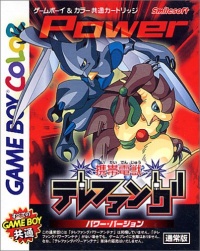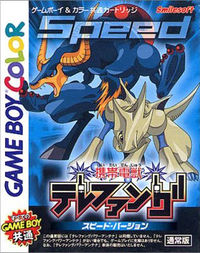Telefang 1: Difference between revisions
m (Tabasuko is Tabasco) |
No edit summary |
||
| Line 12: | Line 12: | ||
| genre = {{w|Console role-playing game}} | | genre = {{w|Console role-playing game}} | ||
| mode = Single player | | mode = Single player | ||
| platform = | | platform = Game Boy Color | ||
| media = 16 megabit catridge }} | | media = 16 megabit catridge }} | ||
Revision as of 23:44, 3 April 2008
| Keitai Denjū Telefang | |
 
| |
| Developer(s) | Smilesoft |
|---|---|
| Publisher(s) | Natsume |
| Designer(s) | Takagi Toushi |
| Release date | 3 November 2000 |
| Genre | Console role-playing game |
| Platform | Game Boy Color |
- For the second version of Keitai Denjū Telefang, see Telefang 2.
- For the Keitai Denjū Telefang series of games, see Keitai Denjū Telefang (series).
Keitai Denjū Telefang (Keitai Denjyuu Terefangu), often shortened to Telefang 1 (since there are two games in this series), is a video game for Game Boy Color released by Smilesoft in Japan. It is available in two versions, namely Power version and Speed version.
The name
Keitai means mobile in Japanese, while Den means electric, jū means monster, and Telefang is a English word in Katakana to mean something like Telephone Fangs (Fangs as in monsters).[1]
Plot
In the year 2020 it was possible to travel to the Denjū world using D-Shots, a special mobile phone. Making friends and sharing telephone numbers with Denjū became popular among humans.
The protagonist, Shigeki, though originally arrived in the Denjū world on accident, he became determined to travel the world with his new Denjū companion, and make more new friends while he was there.
Characters
Humans
- Main article: List of people
- Shigeki () - The protagonist of Telefang 1.
- Matsukiyo () - A child genius who wants to learn more about the Denjū world. He accidentally gets transported there along with Shigeki.
- Miyo () - A strong-willed girl described as a childhood friend of Shigeki, but teases him about never having been to the Denjū world. Her Denjū partner is Suguri.
- Kai () - A mysterious boy encountered during Shigeki's travels, his purpose in the Denjū world is unclear. In the Power Version, his partner is Angios, while in Speed Version it is Gymnos.
- Sanaeba () - The owner of Sanaeba pharmaceutical company, which was the first to discover the Denjū world. After their discovery they began to branch their business into other areas, and they control the human-to-Denjū world gates. While children are allowed in and out for free, adults must pay a fee. Sanaeba seems to have his name attached to many of the problems which have cropped up in the Denjū world, and is apparently manipulating Denjū for unknown reasons.
- Nerikara () - A member of Sanaeba who gets people to vote him for prime minister of the Denjū world by setting up a curry store. The Denjū seem to have a positive response towards curry.
- Tabasco () - A enemy of Shigeki in the Denjū world.
Denjū
- Krypto ()- A strong Denjū with a hot-tempered personality. It is assigned by Musa as Shigeki's first partner in the Power Version.
- Fungus ()- A swift Denjū with a faithful personality. It is assigned by Musa as Shigeki's first partner in the Speed Version.
- Musa - An old, turtle-like Denjū who is the first to greet Shigeki and Matsukiyo after they arrive in the Denjū world. He asks for their help with various problems that the Denjū world is suffering, and introduces Shigeki to his first partner.
- Angios/Gymnos- Partners of Kai (Angios in Power Version and Gymnos in Speed Version).
Power and Speed version differences
The two versions, Power and Speed, have some differences:
- In Power version, the starter partner you will have is Krypto but in Speed version it is Fungus.
- There are different Denjū appearances in the two versions.
- There are some colour differences in the two such as the colour of the D-Shot menu.
- In Paparuna Lake, the order of houses one is required to enter to solve the puzzle is different in Power version than that in Speed version.
Manga
A manga series is available on Kodansha Publishing Ltd. It is based on the first game of the series and it has 3 issues. Some people sell it on the Internet (like Yahoo! Auctions Japan or Amazon Japan).
Sequel
- Main article: Telefang 2
- Main article: Differences between Telefang 1 and Telefang 2
Smilesoft released a sequel to Telefang 1 for the Game Boy Advance, with new Denjū appearances and a slightly different style of battle, where the player can intervene in a middle of a battle to use items on the Denjū. Move types were also introduced.
The sprites were also redrawn, and had better graphics and music.
Bootleg
- Main article: Pokémon Diamond and Jade
Keitai Denjū Telefang was originally only available in Japanese. However, certain pirates in China bootlegged it under the name of Pokémon Diamond and Pokémon Jade. [1] The translation process was not really successful as Engrish was used, and certain profanities were also used. This resulted in a poor reception towards the game, leading many people to think it is a Pokémon ripoff.
The sprites and maps remain the same, changing only the text to English. The ability to name the character or the Denjū was also not present, and the game would also not load a save properly. Many other glitches were also present.
See also
References
- ↑ 1.0 1.1 http://en.wikipedia.org/wiki/Keitai_Denjuu_Telefang. Accessed on 13 January 2008.
| This page uses Creative Commons Licensed content from Wikipedia (view authors). | http://www.wikia.com/images/Smallwikipedialogo.png |